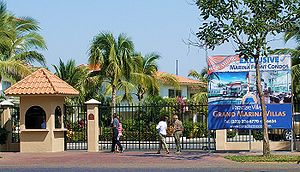
Back Urbanización AN حي سكني مسور Arabic Gated community Czech Gated community Danish Gated Community German Περιφραγμένη κοινότητα Greek Urbanización cerrada Spanish Tarastatud kogukond Estonian Aidattu asuinalue Finnish Résidence fermée French
This article includes a list of general references, but it lacks sufficient corresponding inline citations. (September 2022) |

A gated community (or walled community) is a form of residential community or housing estate containing strictly controlled entrances for pedestrians, bicycles, and automobiles, and often characterized by a closed perimeter of walls and fences. Historically, cities have built defensive city walls and controlled gates to protect their inhabitants, and such fortifications have also separated quarters of some cities. Today, gated communities usually consist of small residential streets and include various shared amenities. For smaller communities, these amenities may include only a park or other common area. For larger communities, it may be possible for residents to stay within the community for most daily activities. Gated communities are a type of common interest development, but are distinct from intentional communities.
For socio-historical reasons, in the developed world they exist primarily in the United States.[1]
Given that gated communities are spatially a type of enclave, Setha M. Low, an anthropologist, has argued that they have a negative effect on the net social capital of the broader community outside the gated community.[2] Some gated communities, usually called "guard-gated communities", are staffed by private security guards and are often home to high-value properties, and/or are set up as retirement villages.
- ^ Lang, Robert E.; Danielsen, Karen A. (1 January 1997). "Gated communities in America: Walling out the world?". Housing Policy Debate. 8 (4): 867–899. doi:10.1080/10511482.1997.9521281. ISSN 1051-1482.
- ^ Low, S (2001) "The Edge and the Center: Gated Communities and the Discourse of Urban Fear" Archived 29 July 2013 at the Wayback Machine, American Anthropologist, March, Vol. 103, No. 1, pp. 45-58. Posted online on 10 December 2004.